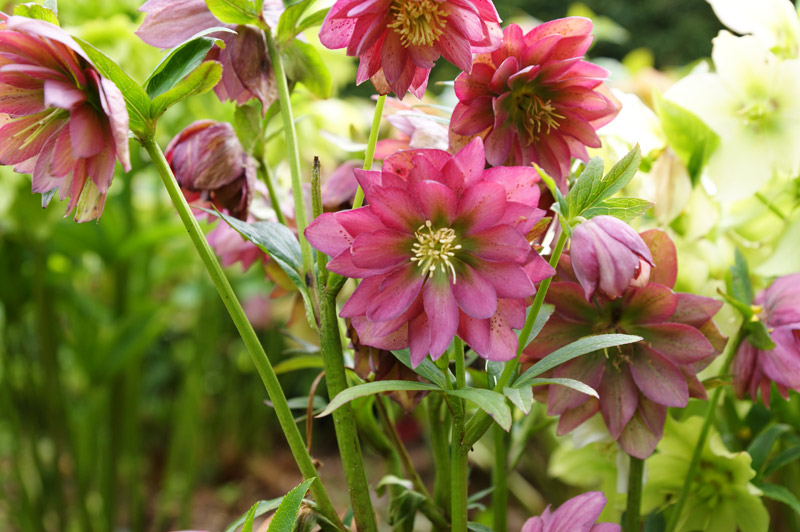May Gardening
Ewshot Gardener in association with Church Crookham and Fleet Garden Society (ccfgsoc.org.uk)
January, February and March are like prison walls to the spirit; April comes as a window opened, admitting sunlight and a patch of blue sky; then May bursts, the rainbow of the months, sent as a sign — a promise of fruition The National Magazine, May 1899
The Society has organised two talks, both are £5 for non-members and £3 for members to cover the costs
Thursday 22nd May – 7.30pm WI Hall Crookham Village A talk by David Standing, retired head gardener of Gilbert White’s House & Gardens Contact Caroline Morris: caroline.morris1958@gmail.com to book.
Monday 16th June – 7.30pm A talk by Helen Baker, RHS Show judge on producing and displaying vegetables, details next month and on the website ccfgsoc.org.uk
All about The Peat
This time last year I wrote about slow gardening and I had intended to continue this theme but at the Trading Shed we are often asked about the whys and how’s of peat composts…… Before the 1950s gardeners made their own potting mixes from resources around the garden – loam (soil), leafmould and homemade compost plus easily purchased grit or sand for drainage and fertliser. In the 50’s the newly opened garden centres realised the soft, lightweight and easily compressed properties of peat presented the opportunity to offer a huge range of potted plants.
What is Peat?
It is a crumbly, spongy, dark brown or black material formed from the partial decomposition of organic matter, primarily plant materials, in waterlogged conditions over long periods, forming peatlands or bogs. This implies peat is a renewable resource and as the peatland ecosystem worldwide covers some 3.7 million square kilometres (1.4 million square miles) no reason to be concerned. Cut by hand then dried in the sun peat has been a source of fuel since Roman times. This destruction although significant does not compare to the huge mechanised extraction industry designed to keep up with the ever-increasing demand of horticulture and agriculture use. In the UK in 1980s this extreme extraction caused sufficient destruction of the water retaining peatbogs to allow flooding of the surrounding areas. So why do we need to preserve peat bogs? Because peat bogs
- Are a source of storage of potable water, for nearly 4% of worldwide population. In UK the 43% of us receive drinking water sourced from peatlands; in Ireland this figure rises to 68%
- Provide flood mitigation such as in Malaysia
- A record of past vegetation and climate by preserving plant remains, such as pollen, allowing for the reconstruction of past environments and the study of land use changes
- Are a very important carbon sink. Globally, peat covers just 3% of the land’s surface but stores up to 550 Giga tonnes of carbon, 42% of all the soil carbon. This exceeds the carbon stored in all other vegetation types, including the world’s forests making them the most efficient carbon sink on the planet. For perspective a 30cm -deep layer of undisturbed peatland holds s much carbon as the same area of rainforest
Unlike our ancestors we now know the organic matter needed to form peat accumulates not quickly but over thousands of years, approximately one millimetre per year. Indeed, most modern peat bogs formed 12,000 years ago at high altitudes after the glaciers retreated at the end of the last ice age. So, my earlier statement ‘peat is renewable’ while true in theory is not a practical solution. To help limit further climate change we now know we need to preserve what peat bogs the world has left, hence the UK Government pledged to ban peat in bagged potting compost by 2024 as part of the measures to reach net zero by 2050.
How to go peat free have different needs to give the same results. The RHS has launched a £1million 5 year research project in collaboration with DEFRA and eight leading commercial growers to trial techniques for successful transition. So far, the results have shown that 80% of plants grow as well if not better in pear free composts. Here are some of the tips from RHS to help with the change, the reasons are in brackets with PFC indicating peat free compost:
- Feed regularly, as much as weekly (PFC is free draining and nutrients are washed out)
- Water thoughtfully, test with a finger before watering (PFC can look dry but are still damp under the surface)
- Seeds need a fine texture so sieve before sowing or use a specialist seed compost with specific fertilisers (PFCs are a mixture of compressed bark, green waste, coir, anaerobic waste, wood fibre and fertilisers so tend to be coarser)
- Principle ingredients will be the same but different brands will have different ratios, so try out different ones
- Buy the best you can afford and blend with other ingredients to go further e.g. sand and grit for drainage; perlite for opening up for seeds and cuttings; soil for containers
- Use spray gun or watering can with gentle rose to water just-sown seeds. Seeds which dry out will not germinate even if rewet
- Mushrooms may appear on the surface, just pick off and add to compost
- Mulch with vermiculite or grit helps retain moisture in all plants and discourage sciarid fly in house plants (these little black flies like PFC!)
What to do this month
May can be a mixed bag weather wise, warm sunny days followed by rainy days and even the occasional late frost so be prepared with fleece or cloches. The warming weather brings forth the weeds and garden pests like slugs and snails. On very warm days open the greenhouse vents, but close in evening as nights can still be cold
Flowers and shrubs
- Put in supports for tall perennials like phlox, delphiniums and asters.
- Mulch borders to retain soil moisture and keep down weeds, could use grass cuttings, leaves, bark, even plain cardboard
- Containers can be started now, but keep in sheltered spot for few days to allow the plants to recover from their transplant
- Spring flowering biennials, that is plants which flower and set seed in their second year, can be sown now. Such as wallflowers, foxgloves, honesty
- Early flowering shrubs, prune by cutting one in three of older stems down to ground level
- Spring flowering bulbs, if display was poor feed with a general-purpose fertiliser as the flowers fade. In pots use a high potassium feed or banana skins
Fruit
- Plant soft fruit such as blueberries, raspberries, blackberries, strawberries, gooseberries. Water regularly during the first year while they are becoming established
- Harvesting rhubarb, leave at least half the stems on each plant
Vegetables
- Potatoes – tubers need protecting from light to avoid the toxin, solanine, forming. Green patches can indicate solanine is present. When shoots appear ‘Earth up’ using soil, leaves or grass cuttings. Leaves do make harvesting easier and as I found last year do not appear to lessen the quantity or quality.
- Tomatoes – start hardening off tomato seedlings for planting outdoors in June
- Broad beans – pinching out the tips once beans start to appear reduces the risk of blackfly
- Put up supports for climbing beans and pea plants outside and tomatoes in the greenhouse
Sowing seeds Sow successionally gives you continuous vegetables Sow indoors: courgettes, cucumbers, lettuce, kale, pumpkins and squash, runner and French bean and sweetcorn Sow outdoors: beetroot, broccoli, Brussels sprouts, carrots, parsnips, radishes, Swiss chard, swede and turnips Plant out: leeks and tomatoes into greenhouses
Rough grass and Lawns
- Feed the lawn with a high-nitrogen fertilizer to encourage strong, healthy growth.
- Sow lawn seed to repair bare patches and water regularly until the new grass is established
- Dig up dandelions and other lawn weeds by hand, if a weed killer is needed for heavy infestations use a selective lawn weedkiller one
- Mow the lawn regularly, once a week probably, lowering the mower blades to their summer level
The Society Trading Shed, Memorial Hall, Sandy Lane opens Saturdays 10am to 11.30am Membership is £5. Dobies offers members 50% discount on seeds and 15% discount on all other items
Website: ccfgsoc.org.uk NB. New web address.
Facebook: Church Crookham and Fleet Gardening Society

